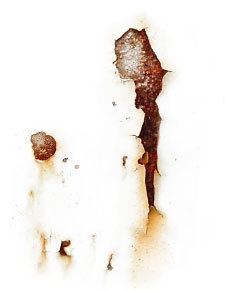







For years I’ve collected old nails, rusty bolts, vintage letterpress, barbwire and almost anything that rusts. One day years ago I bought my first digital camera and started capturing colors I only dreamed of before. Years and thousands of images later I launched the first Rustfetish site in 2003. Now a few years later I decided to share my passion again with an updated site that I actually started 10 years ago. You know life, kids, work, and so many other things competing for time. Click though the images and enjoy the textures and colors like I have for years. I still have a number of prints in my home office that I showed at a gallery exhibit 10 or so years ago. If you are interested in using any of these images please contact me. Vince

What is rust?
Iron oxide, the chemical Fe2O3, is common because iron combines very readily with oxygen -- so readily, in fact, that pure iron is only rarely found in nature. Iron (or steel) rusting is an example of corrosion -- an electrochemical process involving an anode (a piece of metal that readily gives up electrons), an electrolyte (a liquid that helps electrons move) and a cathode (a piece of metal that readily accepts electrons). When a piece of metal corrodes, the electrolyte helps provide oxygen to the anode. As oxygen combines with the metal, electrons are liberated. When they flow through the electrolyte to the cathode, the metal of the anode disappears, swept away by the electrical flow or converted into metal cations in a form such as rust.
For iron to become iron oxide, three things are required: iron, water and oxygen. Here's what happens when the three get together:
When a drop of water hits an iron object, two things begin to happen almost immediately. First, the water, a good electrolyte, combines with carbon dioxide in the air to form a weak carbonic acid, an even better electrolyte. As the acid is formed and the iron dissolved, some of the water will begin to break down into its component pieces -- hydrogen and oxygen. The free oxygen and dissolved iron bond into iron oxide, in the process freeing electrons. The electrons liberated from the anode portion of the iron flow to the cathode, which may be a piece of a metal less electrically reactive than iron, or another point on the piece of iron itself.
The chemical compounds found in liquids like acid rain, seawater and the salt-loaded spray from snow-belt roads make them better electrolytes than pure water, allowing their presence to speed the process of rusting on iron and other forms of corrosion on other metals.
Why would you want to?
We love to capture the process and share with the world.
During the day I work as the Design Director with a great group at Rebuy. Take a look at our product if you run a Shopify store, we would love to help you with personalized recommendations. If you are interested to learn more about Rustfetish why I started it. Follow me on one of the many social sites. Thanks, Vince Stinson.
Rust Never Sleeps!